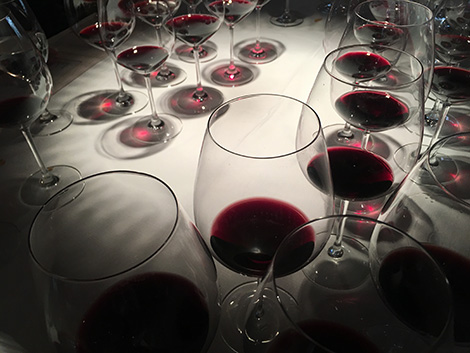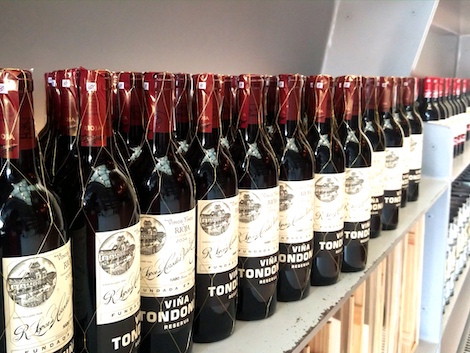
A beacon of modernity in Rioja, in 2006 Marcos Eguren made a wine in the style of the old, long-aged reds of the region at the family winery in San Vicente de la Sonsierra (Rioja Alta). He found inspiration in Castillo Ygay 1925, a wine that left a deep mark in him. “The Ygay I tasted must have been bottled in the 1950s or 1960s,” he recalls. Interestingly, as he tasted different vintages of his new wine, he realized that they complemented each other. So, why not blend them together?
Just a few miles away in Labastida (Rioja Alavesa), Remelluri's best kept secret is a white wine that Telmo Rodríguez started to age in the 2009 vintage. A staunch advocate of what he calls "the taste of a place", his first white in the family property was thoughtfully made under this philosophy. But now Rodríguez has decided to pay tribute to Tondonia’s long-aged white and the art of traditional winemaking and blending. Since Viura does not feature in the Remelluri blend, he is now ageing this indigenous grape variety in old oak barrels sourced from Tondonia. Partly evoking the complexity of Selosse’s solera-style champagnes, Telmo has created a sort of “cascade” of oak containers ending in a large foudre that is annually refreshed with wine from the previous vintage.
Telmo is determined to wait until the 10th year of the solera to bottle the wine, but the Sierra Cantabria CVC was released in October 2017, almost at the same time that Penfolds launched G3, a super-blend of three vintages of the legendary Grange that retails for €2,600.
Available at Vila Viniteca’s online store for €695, Marcos Eguren’s new release is far from cheap. The Rioja winemaker had no qualms about using the acronym CVC ("conjunto de varias cosechas”) that distinguishes multi-vintage blends in Spain despite the fact that it is mostly seen on low-priced, ordinary wines. It is also significant that Vega Sicilia Único Reserva Especial, the benchmark of this category in Spain, is priced higher than the single-vintage Único (€390 compared to €325 at Lavinia wine store in Madrid).
Legal and historical background
If there is one region in the world that can champion the art of blending still wines (Champagne dominates the bubbles), it is Rioja. Although multi-vintage and vintage wines (cue in Riscal’s legendary red wine cellar dating back to 1862) traditionally coexisted in the region, the Champagne model clearly prevailed over Bordeaux’s.
“In the past, labels indicated ageing times like 3rd Year, 5th Year, 6th Year…,” points out Mercedes López from Heredia from Viña Tondonia. “In contrast, the term Reserva was limited to wines that, as the name suggests, were ‘reserved’ in very special vintages and in small quantities due to their outstanding ageing potential. Those were vintage wines through and through and their labels displayed the vintage in large letters like in ‘Cosecha 1947’.”
When he started working in the family winery in San Vicente, Marcos Eguren recalls his father blending vintages for the estate’s 3rd and 5th Year wines. Given that a large majority of producers in Rioja stored their wines in barrels and bottled them upon request, it is not surprising that a series of adjustments and blends were done prior to bottling. Yet the style of each producer also mattered. At Tondonia, for instance, Mercedes López de Heredia says: “the blending of vintages and grape varieties is a powerful and natural tool to achieve balance without having to resort to enological additives which are exogenous to the wine.”
The scene changed following the ministerial order of August 1979 that regulated quality, vintage and ageing designations (the Crianza, Reserva and Gran Reserva terms as we know them today date from this time). Since then, at least 85% of the wine in the bottle needs to be from the vintage stated on the label.
As a result, Rioja’s Regulatory Board began certifying vintages in 1980. Subsequent labelling regulations prevented wines bearing ageing indications (Crianza, Reserva or Gran Reserva) from using multi-vintage blends. The CVC designation serves this purpose.
A terroir-driven CVC
Sourcing grapes from a single vineyard is Marcos Eguren’s contribution to multi-vintage blends. The chosen one is Finca San Pelayo, a 1.49Ha Tempranillo plot planted in 1960 in San Vicente de la Sonsierra. “In the past, Rioja used to produce blended wines with little variations between bottlings that were meant to preserve the style of each producer. In our case, the identity of the wine comes directly from the vineyard,” Eguren points put.
His blend “captures the essence of a vineyard by blurring the vintage print and achieving a balance between more or less tannic vintages and fresher or warmer years,” adds Eguren. The first Sierra Cantabria CVC was bottled in 2015 and blended 2008 (a cold vintage), 2009 (a warm year) and the excellent, well-balanced 2010. When the wine was presented in October 2017 it felt both young and complex, structured and firm, in line with the distinctive style of the Eguren family.
2019 will see a second release: a blend of 2006 (“a warm vintage,” according to Eguren), 2008 (“a cool year”) and 2011 (“a fresh, healthy yet firm vintage with outstanding ripeness but perhaps lacking the perfect balance of 2010”). The Rioja winemaker says that the 2011 vintage makes it posible to bring harmony to 2006 and 2008.
The art of blending
After countless tastings for the book that marked the 150th anniversary of Vega Sicilia, Serena Sutcliffe, head of Sotheby’s international wine department, wrote how complicated it was to blend the different elements of the Reserva Especial and came to the conclusion that “it ages differently to the single-vintage Único.” In her opinion, the fact that the Reserva Especial has been bottled in magnum for the past four years proves that the winery is becoming more confident about the wine’s cellaring potential. Many of her tasting notes are available (in Spanish) on the winery’s website.
Despite being part of Vega Sicilia’s range for a long time, the Reserva Especial was not made purposefully until the 1980s. A blend of vintages destined to Único, it follows a simple set of guidelines which winemaker Gonzalo Iturriaga describes as the combination of a high-quality vintage, a younger, fresher one and a subtler vintage that is meant to add elegance. The 2019 release is a blend of 2006, “one of the best vintages of the 2000s except for 2010 and ahead of 2005”, according to Iturriaga, plus the discrete 2007 and the younger 2009.
The resulting wine may nevertheless include small amounts of wine from other vintages beyond the main three. For instance, blends made late last year for Reserva Especial combined batches from 2014 and 2012 in a large wooden vat. This wine will be eventually blended with another vat containing a blend of 2011 and 2012 and will be eventually refreshed with a younger vintage. The final blend will age for a further year before being bottled. “Given that the Reserva Especial is subtler, more complex and nuanced than the single-vintage Único, it can be enjoyed earlier,” Iturriaga adds.
At Sierra Cantabria, vintages destined to the CVC are aged separately. Despite Marcos Eguren’s modern approach and the fact that his oldest vintage available is 2005, this talented winemaker acknowledges that blending the wines can be extremely challenging. He went through over 40 different blends until he found “balance without loosing the vineyard’s distinctive identity.”
Remelluri avoids such troubles because the solera system naturally dilutes the vintage effect. A mere 3,000 kg of grapes are crushed per year. Fermentation begins in wooden vats and ends in old López de Heredia’s oak casks. In successive stages, the wine moves to larger containers: 500-litre barrels, then 2,800-litre foudres and finally, to 5,000-litre foudres.
Crafting long-aged wines
With all its years of ageing in the cellar and the subsequent adjustments to fill out vats of different sizes, the single-vintage Vega Sicilia Único, usually blends in the 15% that is legally allowed to be added from other vintages. The process is indeed complex. During its first year of ageing, the wine is kept in standard oak barrels, 80% of them new. During the second year, part of the wine goes to used American oak barrels built at Vega Sicilia’s own cooperage and the rest to wooden vats with a capacity that ranges from 8,500 to 22,000 litres. Larger, older vats are employed during the three additional years of oak ageing. “It’s best is to leave the wines untouched at this stage,” warns Iturriaga.
During the third year, the jigsaw starts to take form as some of the batches are blended. In case other vintages need to be added, the blend takes place on the final oak ageing stage. While Único usually benefits from younger vintages (“the better the vintage, the less it needs to be refreshed,” Iturriaga points out), around 3% to 4% of older vintages can be added to Valbuena. “In the end, the single-vintage Único may include two to three vintages after being blended five or six times before bottling,” adds Iturriaga. “As older wines are the base for Reserva Especial, the large wooden vats play a key role during the ageing process and the wine also spends four additional years in bottle before being released.”
Gonzalo Iturriaga thinks that “extended ageing tempers the character of the vintage.” In this sense he champions Valbuena 5º as the wine which better reflects the vintage within Vega Sicilia’s range.
At López de Heredia, even today they rely on a single vintage for their flagship red Tondonia Reserva “and, if necessary, we blend it with vintages from years that are near in time,” Mercedes explains. But the most important thing, she says, is that “blends are based on tastings, vineyards, grape varieties and availability". This means that vineyard management is key to ensure the required quality to “produce year after year wines that have the capacity to improve after almost six years in barrel.”
Other producers in Rioja are introducing changes in that 15% of other vintages that is legally allowed in vintage wines. This is the case of La Rioja Alta, a respected member of Haro’s Barrio de la Estación that is riding high nowadays thanks to their two outstanding 904 and 890 Gran Reserva. Winemaker Julio Sáenz explains that according to records gathered by his predecessor José Gallego in the 1970s and 1980s, it was the norm to add warmer, relatively evolved vintages to the blend prior to bottling in order to bring a sense of maturity.
Since the 1990s, however, they seek the opposite effect and try both to add more freshness and balance out batches with an excess of oak. “Blending other vintages is meant to preserve typicity,” Julio Sáenz explains. Only the best vintages, marked as “Selección Especial”, do not include other vintages.
Vega Sicilia Reserva Especial is far from having remained static. The most important change in recent times involves the lower availability of old vintages. Preserving old wines may be shrouded in romanticism, but many can be flawed along the way and current market trends don’t favour this kind of stocks either. The most recent Reserva Especial releases were based on vintages from the 2000s, older than the current single-vintage Único (2009 this year). The latest Reserva Especial which included vintages from the 1990s (a blend of 1996, 1998 and 2002) was launched in 2016.

Amaya Cervera
A wine journalist with almost 30 years' experience, she is the founder of the award-winning Spanish Wine Lover website. In 2023, she won the National Gastronomy Award for Gastronomic Communication
Wine tastings in March 2019
NEWSLETTER
Join our community of Spanish wine lovers






